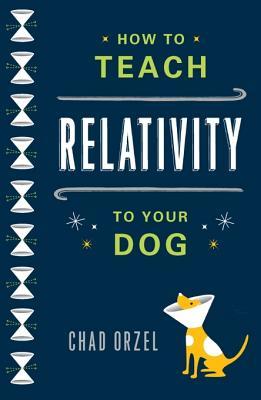
How to Teach Relativity to Your Dog
کتاب های مرتبط
- اطلاعات
- نقد و بررسی
- دیدگاه کاربران
نقد و بررسی

December 12, 2011
Physics professor Orzel follows his How to Teach Physics to Your Dog with a compact and instructive walk through Einstein’s theory of relativity, using the same conceit of lecturing to his preternaturally intelligent and curious dog, Emma. Orzel enthusiastically tackles this elusive subject in chapters with titles like “Time Slows When You’re Chasing Bunnies” and “The Unified Theory of Critters.” The cuteness quotient is high, but the dialogues between author and dog are helpful in explaining the difficult and counterintuitive aspects of relativity. Whether Orzel is writing about the Michelson-Morley experiments, which challenged the previously held notion of universal time and prepared the world of physics for Einstein’s breakthrough, or Einstein’s most famous equation, E=mc2, the prose is breezy and straightforward, and the material well organized. But there is no getting around the subject matter’s difficulty, and while Orzel’s explanatory diagrams featuring the ever-present Emma help readers visualize the abstract theory, the concepts remain challenging. Relativity constantly amazes, and the glimpses of understanding provide rewarding and satisfying moments. B&w illus. Agent: Erin Hosier, Dunow, Carlson & Lerner.

January 15, 2012
Another quirky science primer from the author How to Teach Physics to Your Dog (2009). Traditional popular-science books often feature a teacher answering a child's naive but astute questions. Orzel's (Physics/Union Coll.) talking dog is original without being an improvement. Unlike quantum physics, which remains bizarre even to experts, much of relativity makes sense. Thus, Einstein's special relativity merely states that the laws of physics and the speed of light are identical for all observers in smooth motion. This sounds trivial but leads to weird if delightfully comprehensible phenomena, provided someone like Orzel delivers a clear explanation of why, for example, a stationary observer sees clocks running slower (and so time passing slower) on a moving body. The faster it moves, the slower the clock. Clock and time stop cold at the speed of light, but only the outside observer sees this. Anyone on the moving object sees time passing normally. Having covered other experimentally proven space-time oddities (moving bodies also shrink), Orzel moves on to gravity, the province of general relativity--no less strange but understandable in his expert hands. Under Newton's gravity, objects attracted each other magically across empty space. Einstein provided an explanation; massive bodies warp nearby space, so moving bodies follow the shortest path. Relativity is comprehensible but not simple; comic books have claimed to teach it, but readers discover that cheerful cartoons or animal humor don't eliminate the requirement of reading, perhaps rereading, and reflecting. Those willing to skim the cute teacher-dog exchanges will find themselves in the hands of a skilled educator.
COPYRIGHT(2012) Kirkus Reviews, ALL RIGHTS RESERVED.

March 1, 2013
Eavesdrop on Orzel (How To Teach Physics to Your Dog) as he uses tennis balls, squirrels, and other canine interests to give his pooch a course in relativity. (LJ Xpress Reviews, 2/17/12)
Copyright 2013 Library Journal, LLC Used with permission.

February 15, 2012
Orzel tackles the theory of relativity with the help of his dog, Emmy, who has a somewhat flawed understanding of all that goes into what is probably the most important theory in modern physics. As Orzel points out, one way to approach an understanding of relativity is to think like a dogin other words, look at the world in a different way than we're used to. In the beginning of each chapter, Emmy proposes something she thinks she knows about relativity, such as the fact that time slows down when you're moving faster, and Orzel helps her to understand both a fundamental concept of physics and how it relates to the theory of relativity. Using examples such as a pack of dogs running away from the stationary Emmy, Orzel clearly explains such concepts as the expanding universe. Within each chapter are boldfaced words and phrases that are expanded upon in a glossary. With canine humor and math- or physics-related jokes, Orzel keeps readers interested, while teaching the elements of physics that we promptly forgot after we took the test.(Reprinted with permission of Booklist, copyright 2012, American Library Association.)

























دیدگاه کاربران